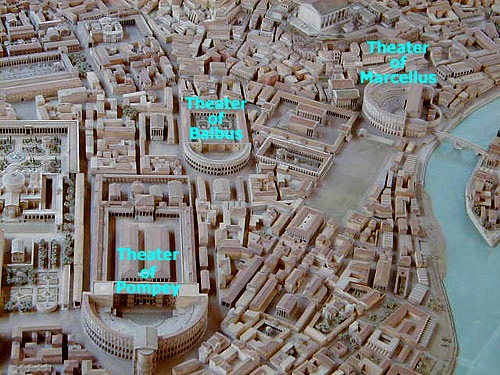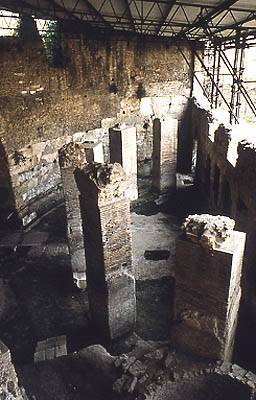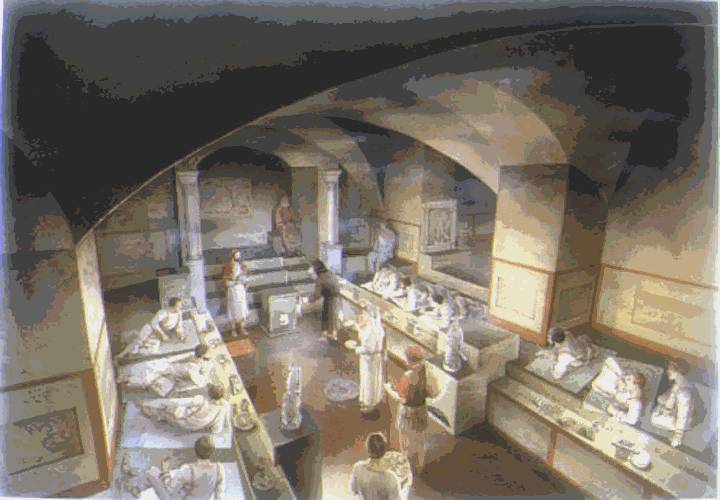
Theater of Balbus

Crypta Balbi: Tired of those same old Ancient Roman museums? Then head for the Museo Nazionale Romano Crypta Balbi, Rome's newest Ancient Roman museum at Via delle Botteghe Oscure, 31, (corner of Via M. Caetani). It opened on April 2, 2000, on the site of the crypta, an enclosed porticoed courtyard, behind the stage of the Theater of Lucius Cornelius Balbus.
The Latin word "crypta" probably originally meant a gallery or extended room in a cavern, but it was later extended to describe man-made tunnels or tunnel like structures. By the time of Augustus, its most common usage was in descriptions of structures like the crypta Balbi: very deep pillared porches around three or four sides of a courtyard. The outside wall was usually windowless, so the ambulatory nearest the wall was dark, and hopefully cool, like a cave.
The Theater of Balbus was right between the Theater of Marcellus and the Theater of Pompey, and, although it was the smallest of the three theaters in the Campus Martius, it was the richest and most interesting architecturally. Its stage was of the finest marbles, and most intricate design. It's seating was richer, and its small size made it both more intimate and more selective in its audience. Having Balbus, one of Augustus' best Generals and most important military advisors as its patron surely would also have attracted the upper class audience.
And then there was the crypta, a place of relaxation and refreshment back stage. Roman stage productions were notoriously long, and several different plays might be run in a string -- double, triple, quadruple features and more. You went to the theater like you went to the games -- for a full day. There had to be a place to spend the intermissions, to skip a too familiar production, to gossip, to see and be seen -- to hang out. There was usually a temple in the center of the courtyard where actors prayed for good reviews and friendly audiences -- written prayers survive. Stalls for food and drink filled the space between the temple and the porticoes. There may have been canopies or roofed pavilions -- surviving pictures are hard to interpret. In higher class theater/courtyard complexes like the Theatrum and crypta Balbi, the porticoes had no commercial uses: they were richly decorated and furnished for the use of the theatergoers. (The backstage portico at Ostia had guild and shipping company offices, the one in Pompeii seems to have had travel agencies and "escort services" offices.) Balba's porticoes also had an upper level just as richly made and decorated as the courtyard level. You need to stand on the piano nobile level balcony overlooking the inner courtyard of the Palazzo Venezia gallery, three blocks to the east, to get the effect.
Over the centuries, the crypta and courtyard evolved as markets, warehouses, churches, houses, workshops, factories, hospices, food distribution centers all had their day, until it was finally abandoned to fall into ruins. Twenty years of excavation, interpretation, and restoration funded by the Jubilee Fund and Roma Capitale legislation and carried out by the Rome Archeology Board were needed to open the Museum. Work continues on adjoining structures, which will be incorporated as they are finished.
Museums come in two types: the "Wow, look at that", tourist kind and the "museo didattico" kind aimed at and frequented by serious students. The Crypta Balbi is unashamedly in the second category. Explanatory text is detailed and in English as well as Italian. Display cases and wall and floor units are simple, well lit, and not distracting. The collection is representative of the masses of artifacts found at the site and is arranged chronologically with the ground floor having the oldest and upper floors having more recent displays. Architectural elements are displayed in context and proper positions with original parts and reconstructions easily distinguishable. There are several "wells" down which you can look to see the lowest excavated levels, several meters below the ground floor.
The only complaint heard was about the modern elements -- too many dizzying sweeping and swooping stairways inside the exits and entrances. The back stairway, on the other hand is new, but very authentically "ancient Roman" in design and decoration. Except for a very small display area five meters above floor level on the top floor, the whole museum is wheel chair accessible, with elevators between floors and ramps between levels on the ground floor. Like all Roman museums the Museo Crypta Balbi needs many more chairs and benches in display areas. A small bookstore is open with a promise of a much larger one. There are clean restrooms on each level. There is no cafe or refreshment area installed or planned -- but the site is only one block from Piazza Argentina.
----------
The Crypta and the theater went into decline rather quickly and some parts of the structure were put to other uses.
In 80 CE the Great Fire in the Campus Martius badly damaged the Theater of Balbus, as well as the Theater of Pompey and many other monuments which Dio Cassius (c. 220 CE) enumerates (Roman Histories 66.24.1-3).
Domitian (81-96) undertook a major renovation of the Campus Martius which probably included the Balbus complex, for closure of the niches in the external facade, datable to this period, indicate that the crypta at least was already assigned to other functions (possibly as the headquarters of the vigiles).
Under Hadrian (117-138), the portico of the crypta was again modified, with the exedra converted into a huge latrine.
Evidence for the continued existence of the Balbus complex in the age of Constantine is provided by the 4th Century Notitia Regionum XIV, which describes noteworthy objects in the fourteen regions of Rome. The list for Regio IX contains entries for each of the three theaters of the Campus Martius, as well as an entry for "Cripta Balbi."
In late antiquity repeated violent floods of the Tiber, sacks of Rome, damaging earthquakes, fires, and private use took their toll of the complex. The emperor Theodoric undertook the final restoration of the crypta in 507-511.
Of the subsequent phases of the site which the Crypta Balbi museum publication documents, Daniele Manacorda writes in her introduction : "The excavations soon revealed that life had continued on the site of the Crypta Balbi after antiquity. A continuous sequence of transformation and reuse of the monument ran through the Middle Ages and the Renaissance until the modern era" (Museo Nazionale Romano Crypta Balbi, produced by the Ministero per i Beni e la Attivita Culturali (Milano: Electa, 2000, p. 5).
Between the 7th-9th century the exedra was used as a glass factory, a trash dump, and a lime factory, where ancient materials from the Balbus site and from all over Rome were reduced. During the Middle Ages a church was built over the temple-like structure in the center of the crypta and the theater served as a foundation for a large building, the Castrum Aureum.
----------
The Balbus theatre was the third stone theater built in Rome (after the theatres of Pompey and Marcellus, but actually dedicated shortly before the official dedication of the Theater of Marcellus). It was richly decorated and behind the stage there was a plush arcade area -- the theatre was designed to appeal to the upper classes. The Regional Catalogues identified the Balbi Crypta as part of the arcade area: it may have been an ambulatory between the open part of the arcade facing inward toward the courtyard and the external wall at the outer perimeter, an area which would have provided more protection during inclement weather. It is also possible that the word "Crypta" referred to a pre-existing street that was vaulted over to allow the courtyard and its porticoes to be built symmetrically.
The building now on the site of the Crypta Balbi now houses a section of Museo Nazionale Romano which tells the story of urban development in the Crypta Balbi area from ancient times.
 ßThe
Exedra at the back of the courtyard was converted into a latrine and also
was the site of Medieval burials.
ßThe
Exedra at the back of the courtyard was converted into a latrine and also
was the site of Medieval burials.
---------------
The theatre and the vast porticus of L. Cornelius Balbus (procos. Africae 21/0 BC) , at the extreme southern tip of the Campus Martius, were built in celebration of Balbus' victory over the Libyan Garamantes in 19 BC and completed in 13 BC. The theatre is completely concealed beneath the palazzi Caetani and Mattei which front onto the Via Michelangelo Caetani, but the porticus, on the site of the former convent of S. Caterina dei Funari, has been the focus of extensive archaeological investigation since 1981. The Northern boundary of the site is the Via delle Botteghe Oscure, to the East, Via Palacchi and the Piazza Margana, to the South Via dei Delfini (see the map in L. Richardson, New Topographical Dictionary, p.381 fig. 80). The walls of the porticus (as rebuilt after the fire of 80 AD) have been revealed to be still standing up to heights of more than 12m behind the facades of the buildings on Via delle Otteghe Oscure and dei Delfini. The whole area continued to be intensively settled in late antique Rome, and the upper levels have revealed extensive industrial activity, including glass-blowing, and bronze-founding. After ceasing for a while in the early 1990s, the excavations were continued recently under the direction of Prof. Daniele Manacorda, and in 2000 the remains of a large mithraeum were discovered on the ground floor of the porticus immediately to the South of the apsidal development in the centre of the Eastern perimeter wall, marked in Richardson's map as a series of large vaults. These have now been shown to have reached a height of four storeys, so that the mithraeum was in the middle of a densely populated insula. The overall dimensions of the temple were 31.5m long and ca. 12 m wide, and it could be entered from several points. It seems to have been founded in the late Antonine or early Severan period (ca. 200 AD), and to have ceased to be used as a mithraeum some time in the later fourth century AD, though these dates are still somewhat speculative. Some time after its closure as a mithraeum, it was completely filled with rubble, which, as in the case of S. Prisca on the Aventine, has made the task of determining what materials belong to the mithraeum and what is adventitious particularly difficult. But a large fragment of an early third-century bull-killing relief, altars and a number of multi-nozzled lamps certainly belong to the temple.

Reconstruction of the Crypta Balbi Mithraeum
---------------
LUCIUS CORNELIUS BALBUS the younger received the Roman citizenship at the same time as his uncle, who had distinguished himself in putting down a revolt in Spain in 70 BC. During the civil war between Caesar and Pompey, he served under Caesar, by whom he was entrusted with several important missions. He also took part in the Alexandrian and Spanish wars. He was rewarded for his services by being admitted into the college of pontiffs. In 43 he was quaestor in Further Spain, where he amassed a large fortune by plundering the inhabitants. In the same year he crossed over to Bogud, king of Mauretania, and is not heard of again until 21, when he appears as proconsul of Africa. Mommsen thinks that he had incurred the displeasure of Augustus by his conduct as praetor, and that his African appointment after so many years was due to his exceptional fitness for the post. In 19 Balbus defeated the Garamantes, and on the 27th of March in that year received the honor of a triumph, which was then for the first time granted to one who was not a Roman citizen by birth, and for the last time to a private individual. He built a theatre in the capital, which was dedicated on the return of Augustus from Gaul in 13 (Dio Cassius liv. 25; Pliny, Nat. Hist. xxxvi. 12. 60). Balbus appears to have given some attention to literature. He wrote a play of which the subject was his visit to Lentulus in the camp of Pompey at Dyrrhachium, and, according to Macrobius (Saturnalia, iii. 6), was the author of a work dealing with the gods and their worship. The name Balbus means "one who stammers".